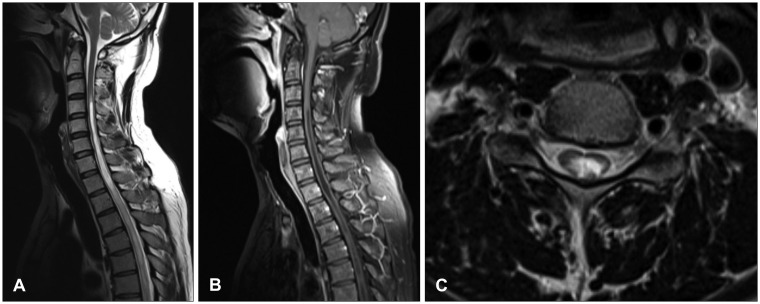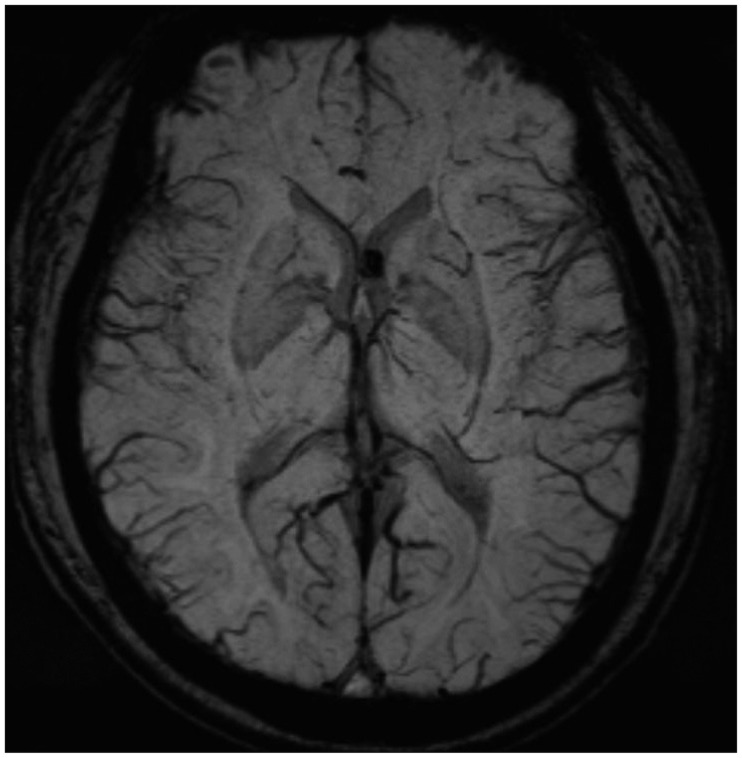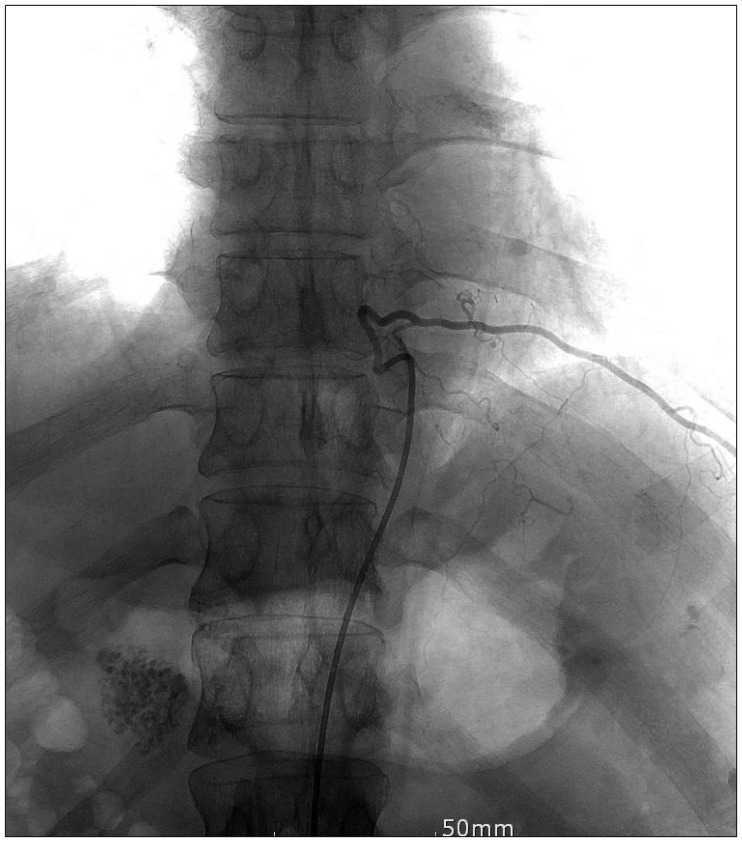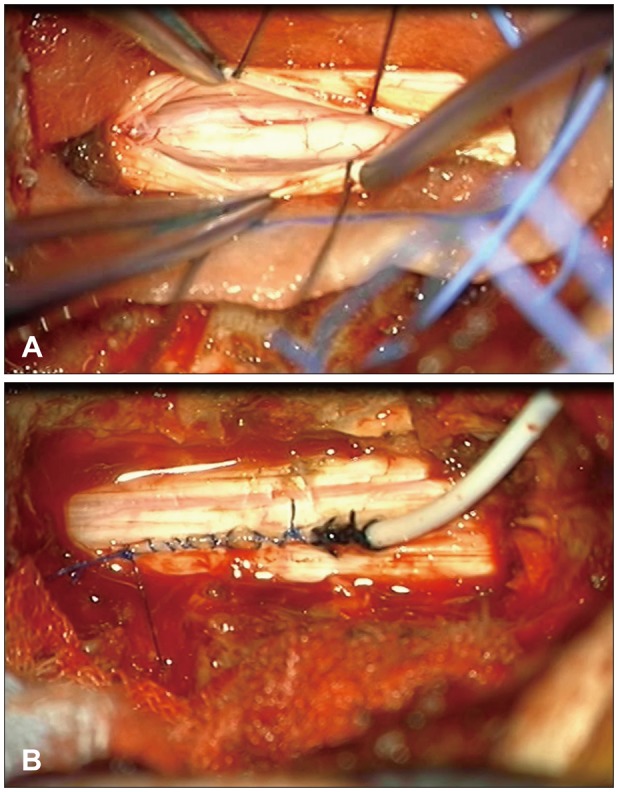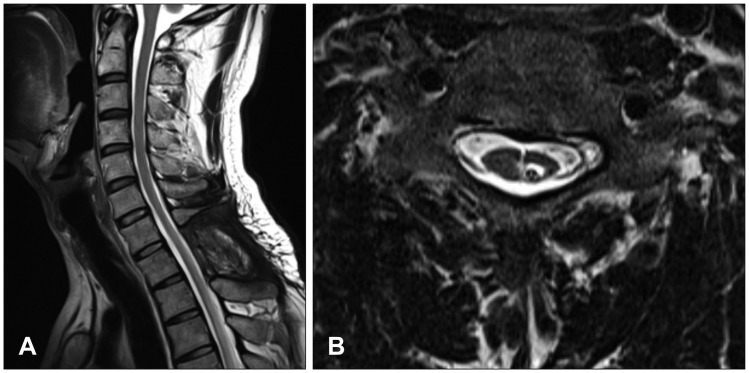Korean J Neurotrauma.
2017 Apr;13(1):34-38. 10.13004/kjnt.2017.13.1.34.
Surgical Management of Syringomyelia Associated with Spinal Adhesive Arachnoiditis, a Late Complication of Tuberculous Meningitis: A Case Report
- Affiliations
-
- 1Department of Neurosurgery, Pusan National University Yangsan Hospital, Pusan National University School of Medicine, Yangsan, Korea. gnsong50@gmail.com
- KMID: 2378248
- DOI: http://doi.org/10.13004/kjnt.2017.13.1.34
Abstract
- Syringomyelia associated with tuberculous meningitis is an extremely rare condition. Only a few studies have reported clinical experience with syringomyelia as a late complication of tuberculous meningitis. Twenty-six years after a tuberculous meningitis episode, a 44-year-old man presented with progressively worsening spastic paresis of the lower limbs and impaired urinary function for 2 years. Radiological examination revealed syringomyelia extending from the level of C2 to T9 and arachnoiditis with atrophy of the spinal cord between C2 and T3. We performed laminectomy from C7 to T1, dissected the arachnoid adhesion and placed a syringo-pleural shunt via keyhole myelotomy. One year after the operation, his neurological condition improved. The postoperative control magnetic resonance imaging revealed the correctly located shunt and significantly diminished syringomyelia cavities. We aim to discuss the mechanism of syrinx formation following tuberculous meningitis and to share our surgical therapeutic experience with this rare disease entity.
MeSH Terms
Figure
Reference
-
1. Cacciola F, Capozza M, Perrini P, Benedetto N, Di Lorenzo N. Syringopleural shunt as a rescue procedure in patients with syringomyelia refractory to restoration of cerebrospinal fluid flow. Neurosurgery. 2009; 65:471–476. PMID: 19687691.
Article2. Caplan LR, Norohna AB, Amico LL. Syringomyelia and arachnoiditis. J Neurol Neurosurg Psychiatry. 1990; 53:106–113. PMID: 2313296.
Article3. Chang HS, Nakagawa H. Theoretical analysis of the pathophysiology of syringomyelia associated with adhesive arachnoiditis. J Neurol Neurosurg Psychiatry. 2004; 75:754–757. PMID: 15090573.
Article4. Edgar R, Quail P. Progressive post-traumatic cystic and non-cystic myelopathy. Br J Neurosurg. 1994; 8:7–22. PMID: 8011197.
Article5. Fehlings MG, Bernstein M. Syringomyelia as a complication of tuberculous meningitis. Can J Neurol Sci. 1992; 19:84–87. PMID: 1562914.
Article6. Fischbein NJ, Dillon WP, Cobbs C, Weinstein PR. The “presyrinx” state: a reversible myelopathic condition that may precede syringomyelia. AJNR Am J Neuroradiol. 1999; 20:7–20. PMID: 9974051.7. Kaynar MY, Koçer N, Gençosmanoğlu BE, Hanci M. Syringomyelia-as a late complication of tuberculous meningitis. Acta Neurochir (Wien). 2000; 142:935–938. discussion 938-939. PMID: 11086834.8. Klekamp J. Treatment of syringomyelia related to nontraumatic arachnoid pathologies of the spinal canal. Neurosurgery. 2013; 72:376–389. PMID: 23208064.
Article9. Klekamp J, Batzdorf U, Samii M, Bothe HW. Treatment of syringomyelia associated with arachnoid scarring caused by arachnoiditis or trauma. J Neurosurg. 1997; 86:233–240. PMID: 9010425.
Article10. Koyanagi I, Iwasaki Y, Hida K, Houkin K. Clinical features and pathomechanisms of syringomyelia associated with spinal arachnoiditis. Surg Neurol. 2005; 63:350–355. discussion 355-356. PMID: 15808720.
Article11. Muthukumar N, Sureshkumar V. Concurrent syringomyelia and intradural extramedullary tuberculoma as late complications of tuberculous meningitis. J Clin Neurosci. 2007; 14:1225–1230. PMID: 18029276.
Article12. Ohata K, Gotoh T, Matsusaka Y, Morino M, Tsuyuguchi N, Sheikh B, et al. Surgical management of syringomyelia associated with spinal adhesive arachnoiditis. J Clin Neurosci. 2001; 8:40–42.
Article
- Full Text Links
- Actions
-
Cited
- CITED
-
- Close
- Share
- Similar articles
-
- A Case of Syringomyelia Following Cured Tuberculous Meningitis
- Syringomyelia Associated with Arachnoiditis Developed after Spinal Anesthesia
- Syringomyelia & Syringobulbia in a Patient of Paraplegia Following Tuberculous Meningitis: Case report
- Surgical Treatment of Syringomyelia Secondary to Tuberculous Meningitis: Report of 4 Cases
- Intradural Extramedullary Tuberculoma of the Spinal Cord Following Tuberculous Meningitis

